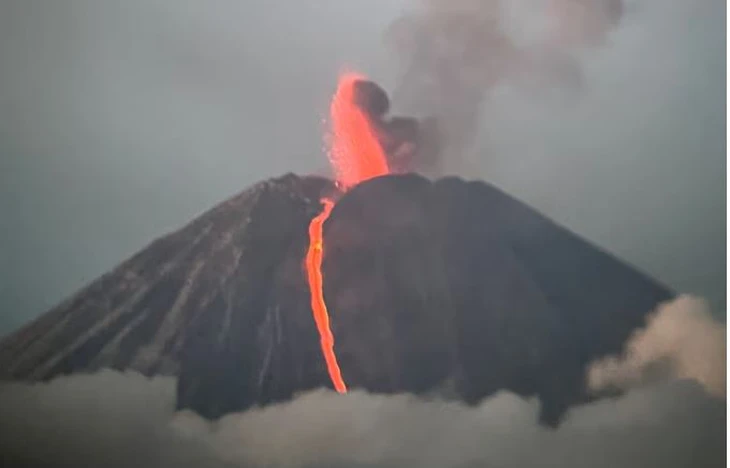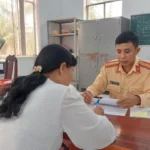The destruction of the aforementioned dam has raised concerns about the risk of mudflows and transportation disruptions in the area.
The Institute of Volcanology and Seismology, part of the Far Eastern Branch of the Russian Academy of Sciences, reported that a field survey conducted from July 30 to August 2 near the Studenaya River revealed the dam had collapsed, allowing water to flow freely.
The dam was built in 2023 to separate the right and left channels of the river.
Scientists explained that the damage was caused by increased activity following a powerful earthquake on July 30.
Currently, lava from the Klyuchevskoy volcano is flowing toward the Bogdanovich Glacier, causing rapid melting. The meltwater is rushing down the mountain slopes, forming large-scale mud and debris flows.
Experts warn that if these mudflows intensify, they could pose a direct threat to tourists in the Tolbachinsky Valley.
Located about 450 km north of Petropavlovsk-Kamchatsky (the capital of Kamchatka), Klyuchevskoy is one of the tallest volcanoes in the world.
This volcano has erupted several times in recent years.
The recent earthquake off the coast of Kamchatka damaged buildings and injured several people in Russia’s eastern region.
A magnitude 8.8 earthquake off the Kamchatka Peninsula triggered simultaneous activity in seven volcanoes, a rare phenomenon not seen in nearly 300 years.
Klyuchevskoy volcano
Klyuchevskoy Volcano, located on Russia’s Kamchatka Peninsula, is the tallest active volcano in Eurasia, rising to 4,750 meters (15,584 feet). Formed around 7,000 years ago, it has erupted frequently since its first recorded eruption in 1697, making it one of the most active volcanoes in the world. Its dramatic eruptions and conical shape attract scientists and adventurers, while its surrounding landscape is part of the UNESCO-listed Volcanoes of Kamchatka site.
Kamchatka Peninsula
The Kamchatka Peninsula, located in Russia’s Far East, is a remote and volcanic region known for its stunning natural beauty, including over 160 volcanoes (29 of which are active) and the UNESCO-listed Volcanoes of Kamchatka. Historically inhabited by indigenous peoples like the Itelmens and Koryaks, the peninsula was explored by Russian Cossacks in the 17th century and later became a strategic military zone during the Soviet era. Today, it is celebrated for its pristine wilderness, geothermal wonders, and abundant wildlife, including brown bears and Steller’s sea eagles.
Studenaya River
The Studenaya River (Russian: Студеная река) is a small river in Russia, known for its cold, clear waters—hence its name, which translates to “Cold River.” It flows through the Primorsky Krai region in the Russian Far East and is part of the larger Ussuri River basin. Historically, the area around the Studenaya River has been inhabited by indigenous peoples and later explored by Russian settlers in the 19th century.
Bogdanovich Glacier
Bogdanovich Glacier is a glacier located in the Pamir Mountains of Tajikistan. It was named after the Russian glaciologist Konstantin Bogdanovich, who contributed to the study of Central Asia’s glaciers in the early 20th century. The glacier is part of a region known for its rugged, high-altitude landscapes and plays a role in feeding into the larger river systems of Central Asia.
Tolbachinsky Valley
The Tolbachinsky Valley, located in Russia’s Kamchatka Peninsula, is a striking volcanic region known for its dramatic landscapes formed by eruptions of the Tolbachik volcanic complex. The area gained scientific attention after the major 1975-1976 Great Tolbachik Fissure Eruption, which created new lava fields and cones. Today, it attracts researchers and adventurers for its unique geology and ongoing volcanic activity.
Petropavlovsk-Kamchatsky
Petropavlovsk-Kamchatsky is a city in Russia’s Far East, located on the Kamchatka Peninsula. Founded in 1740 during Vitus Bering’s expedition, it serves as a key port and cultural hub in the region, surrounded by volcanoes and rich in indigenous Itelmen and Koryak heritage. Today, it is known for its dramatic landscapes, wildlife, and as a gateway to Kamchatka’s natural wonders.
Far Eastern Branch of the Russian Academy of Sciences
The Far Eastern Branch of the Russian Academy of Sciences (FEB RAS) is a major scientific research center established in 1932 in Vladivostok, Russia, to advance studies in the natural and social sciences in the Far East region. It plays a key role in researching the unique ecosystems, geology, and indigenous cultures of the Russian Far East, as well as fostering international scientific collaboration in Asia-Pacific studies. Over the decades, it has expanded to include numerous institutes focused on marine biology, volcanology, economics, and regional history.
Institute of Volcanology and Seismology
The **Institute of Volcanology and Seismology** is a scientific research institution dedicated to studying volcanic activity, earthquakes, and related geological hazards. Typically found in regions prone to such phenomena (e.g., Russia’s Kamchatka Peninsula or Ecuador), these institutes monitor eruptions, predict seismic events, and contribute to disaster risk reduction. Their work dates back to the mid-20th century, evolving with advancements in geophysical technology to better understand and mitigate natural disasters.






